Aug. 6 to Aug. 12
The “iron typhoon” (鐵颱) caused the sky to turn black for three days. The wind blew wildly and rain seemed to fall endlessly from the sky. When a river overflowed, it swallowed the fields and turned the land into a vast lake. Water, rocks and sand flooded a village, and the lower-lying parts were completely submerged. The current spread livestock in all directions, and most people lost all their property. Even the terrain changed. The river shifted 300 meters to the west, the old sandbanks disappeared and sediment created new ones, some of which measured three stories high.
This is an account by residents of Hsihu Township (溪湖) in Changhua County on the Great Flood of 1898 (戊戌大水災). Taking place on Aug. 6, it is one of three major floods this week in history to wreak havoc on central and southern Taiwan.
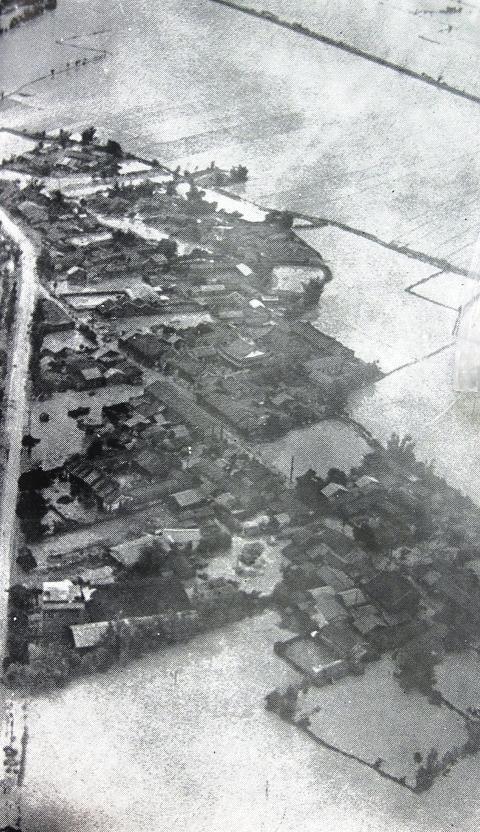
Photo courtesy of Wikimedia Commons
The next one, on Aug. 7, 1959, caused over 1,000 deaths and disappearances and is ranked among the deadliest natural disasters in Taiwan since World War II. The Aug. 8, 2009 floods caused by Typhoon Morakot are probably still relatively fresh in most people’s minds and will not be discussed in this column.
ORIGIN OF A SNACK
Before discussing the 1898 flood itself, the disaster is widely believed to have led to the creation of one essential Taiwanese street food: bawan (肉圓), translucent disk-shaped dough filled with pork and bamboo shoots.
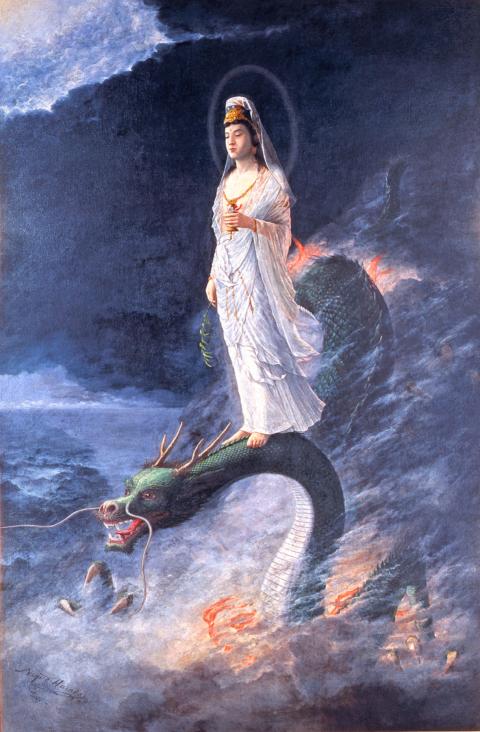
Photo courtesy of Wikimedia Commons
This story was most recently recounted in May by a Changhua County Cultural Affairs Bureau publication. Since the flood had drenched all the firewood and destroyed most people’s stoves, the locals had nothing to eat but sweet potatoes. Nor could they make the usual glutinous rice snacks to appease the spirits during Ghost Month.
After the flood, Fan Wan-chu (范萬居), a spirit medium and scribe at a local temple, became possessed by a deity. While under a trance, he wrote down a recipe that used sweet potato powder and vegetables to create a delicacy that resembled glutinous rice cake, so villagers could worship and distribute them as disaster relief. Over the generations, bawan developed into the form we know today. Fan’s great-grandson continues to sell bawan in the same area.
The local Jhuoshuei River (濁水溪) had a long history of flooding. Sediment accumulation caused the river to change course often, and every course change meant flood. Qing Dynasty records show 11 disasters between 1749 and 1792, as well as 1892 and 1893. Records also show that an entire village had to relocate in 1806. However, none of these reports were very detailed, writes Chang Su-fen (張素玢) in the book 300 Years of the Jhuoshuei River (濁水溪三百年). The 1898 flood, on the other hand, was carefully documented by the Japanese colonizers.

Photo: Liu Hsiao-hsin, Taipei Times
This flood was a combination of heavy rains brought by a typhoon and one of the river’s tributaries dyke breaking, leading to a complicated series of course shifts and finally the bursting of the riverbank. The devastation was not only brought by the water but massive sediment accumulation, leading to an exodus of the affected areas. Official records show 182 casualties with 6,165 houses completely destroyed and 5,045 partially ruined. The flood significantly transformed the area’s terrain, leading to much resettlement.
Siho resident Yang Hsing-hsin (楊興新) recalls that his entire village scattered in all directions, but his family eventually returned after more than 10 years since they still owned the land there.
Chang writes that the flood left a deep impression on the area’s residents as the affected families were mostly able to clearly describe the events and their ensuing fates, even when they had only heard it from older relatives. She cross-checked the accounts with those of other neighbors and found that they mostly matched.
GUANYIN ON THE DRAGON
Chiayi County’s Pitzu Village (埤子村) was one of the most seriously affected villages during the 1959 floods, as it was located right by the Chianan Irrigation Canal (嘉南大圳) as well as at the head of a tributary to the Beigang River (北港溪). The levee burst in the wee hours of Aug. 8, destroying the entire village of 60 households.
In the past, the water behind the levee would rise slowly, giving residents time to collect their items and evacuate. But this time, the levee beyond Pitzu broke first, and the accumulated water simply crashed right through Pitzu’s levee, immediately destroying to nearest 20 houses, leaving just a flat bed of sand. All the farm animals were lost — including water buffalo — save for six geese and three chickens.
This disaster was caused indirectly by Typhoon Ellen, which caused Tropical Storm 81 to change course toward Taiwan. The storm landed near Budai Township (布袋) in Chiayi County and soon weakened and disappeared — but not without causing massive rains. Reports show that rainfall in central and southern Taiwan on Aug. 7 alone almost reached the area’s annual levels.
Changhua City and its surrounding townships also suffered great damage as 1,102 meters of the Dadu River’s (大肚溪) left bank burst, leaving the entire city flooded. The shallowest areas were 3 meters deep. The water did not recede until the morning of Aug. 9.
This flood was far more devastating than that of 1898, affecting an area of 1,365 square meters and 30,000 households. More than 1,000 people died or disappeared, with 27,466 houses destroyed and 18,303 partially collapsed.
Legend had it that a popularly worshiped picture of Guanyin riding a dragon in a storm, which could be seen in many Buddhist, Taoist and other folk temples between 1960 and 1980, originated from a photo taken during the flood as the goddess of mercy and compassion arrived to save the people. However, it was later proven that it was a copy of a 1890 Japanese painting.
Taiwan in Time, a column about Taiwan’s history that is published every Sunday, spotlights important or interesting events around the nation that have anniversaries this week.
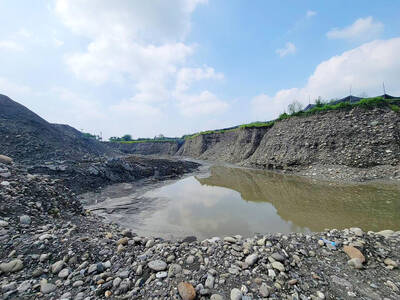
Last week the story of the giant illegal crater dug in Kaohsiung’s Meinong District (美濃) emerged into the public consciousness. The site was used for sand and gravel extraction, and then filled with construction waste. Locals referred to it sardonically as the “Meinong Grand Canyon,” according to media reports, because it was 2 hectares in length and 10 meters deep. The land involved included both state-owned and local farm land. Local media said that the site had generated NT$300 million in profits, against fines of a few million and the loss of some excavators. OFFICIAL CORRUPTION? The site had been seized
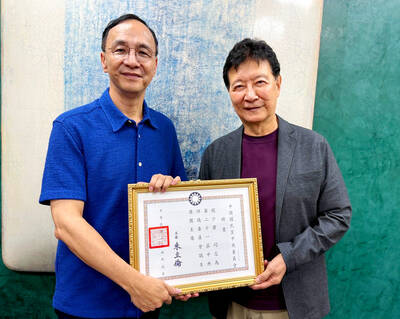
Next week, candidates will officially register to run for chair of the Chinese Nationalist Party (KMT). By the end of Friday, we will know who has registered for the Oct. 18 election. The number of declared candidates has been fluctuating daily. Some candidates registering may be disqualified, so the final list may be in flux for weeks. The list of likely candidates ranges from deep blue to deeper blue to deepest blue, bordering on red (pro-Chinese Communist Party, CCP). Unless current Chairman Eric Chu (朱立倫) can be convinced to run for re-election, the party looks likely to shift towards more hardline
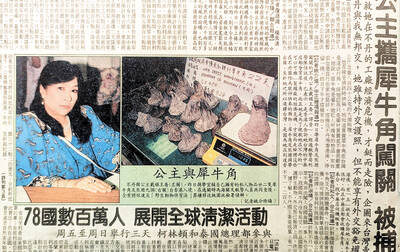
Sept. 15 to Sept. 21 A Bhutanese princess caught at Taoyuan Airport with 22 rhino horns — worth about NT$31 million today — might have been just another curious front-page story. But the Sept. 17, 1993 incident came at a sensitive moment. Taiwan, dubbed “Die-wan” by the British conservationist group Environmental Investigation Agency (EIA), was under international fire for being a major hub for rhino horn. Just 10 days earlier, US secretary of the interior Bruce Babbitt had recommended sanctions against Taiwan for its “failure to end its participation in rhinoceros horn trade.” Even though Taiwan had restricted imports since 1985 and enacted

Enter the Dragon 13 will bring Taiwan’s first taste of Dirty Boxing Sunday at Taipei Gymnasium, one highlight of a mixed-rules card blending new formats with traditional MMA. The undercard starts at 10:30am, with the main card beginning at 4pm. Tickets are NT$1,200. Dirty Boxing is a US-born ruleset popularized by fighters Mike Perry and Jon Jones as an alternative to boxing. The format has gained traction overseas, with its inaugural championship streamed free to millions on YouTube, Facebook and Instagram. Taiwan’s version allows punches and elbows with clinch striking, but bans kicks, knees and takedowns. The rules are stricter than the